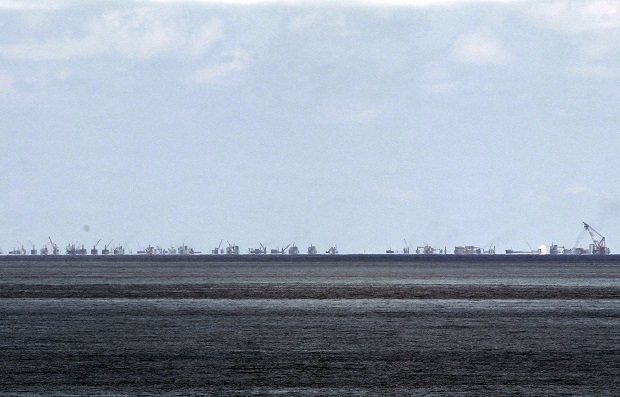
The alleged on-going reclamation of Subi Reef by China is seen from Pag-asa Island in the Spratly Islands in the South China Sea, western Palawan Province, Philippines Monday, May 11, 2015. Gen. Gregorio Pio Catapang, the Philippines’ military chief has flown to the Filipino-occupied island of Pag-asa in the South China Sea amid territorial disputes in the area with China, vowing to defend the islet and help the mayor develop tourism and marine resources there. AP
The dispute over the strategic waterways of the South China Sea has intensified, pitting a rising China against its smaller and militarily weaker neighbors who all lay claim to a string of isles, coral reefs and lagoons known as the Spratly and the Paracel islands. Only about 45 of them are occupied. The area is one of the world’s busiest shipping routes, rich in fish and potentially gas and oil reserves, but it has now emerged as a possible flashpoint involving world powers and regional claimants.
A look at some of the most recent key developments:
___
US RATCHETS UP PRESSURE ON CHINA
The U.S. military has begun actively — and more publicly — challenging China’s sovereignty claims over half a dozen artificial islands Beijing has been rapidly constructing through massive land reclamation.
On May 22, a U.S. Navy P-8A Poseidon surveillance aircraft — a militarized version of the Boeing 737 — flew from Clark Air Base in the Philippines over Mischief Reef and Fiery Cross Reef, previously submerged coral features that China occupied in the mid-1990s and late 1980s, and is now expanding into a landmass several times their original size. Recent satellite images show the construction of an airstrip, port facilities, cement factories and barracks, among other installations. U.S. defense officials also revealed that China had put two large artillery vehicles on one island.
In a video captured by CNN, which had a crew on the P-8 flight, China’s navy dispatcher warned the plane eight times to leave the area, and each time the U.S. pilots responded by saying: “I am a United States military aircraft conducting lawful military activities acting outside national airspace. I am with due regard in accordance with international law.”
The U.S. refuses to recognize China’s sovereignty over disputed islands. Defense Secretary Ash Carter said the U.S. will continue to enforce freedom of navigation in what it considers international waters. U.S. officials are concerned that China could use the islands to fortify its claims and gain the upper hand by force and intimidation.
Washington is considering more military flights and naval patrols, possibly within 12 nautical miles of the islands — a parameter China considers its territorial waters.
The littoral combat ship USS Fort Worth, among the Navy’s most modern vessels, in May completed its patrol of the South China Sea. It encountered a Chinese navy ship, but they contacted each other to avoid any mishap, according to U.S. military officials.
Capt. Fred Kacher, commodore of the destroyer squadron, said routine operations like this in the South China Sea “will be the new normal” as four more littoral warships are expected to be deployed in the region.
___
CHINA STANDS BY ISLAND-BUILDING, TELLS MILITARY TO PROTECT SEAS
China says it is “extremely concerned” with the possibility that the U.S. could start patrolling close to the islands.
Foreign Ministry spokesman Hua Chunying says freedom of navigation does not mean that foreign military ships and aircraft can enter another country’s territorial waters or airspace at will. Hua said that China has always safeguarded the freedom and safety of navigation and overflight in the South China Sea.
Defense Ministry spokesman Yang Yujun compared the island-building to ordinary construction, such as road-building going on elsewhere in the country. He says such activities are designed to satisfy both military and civilian purposes.
Yang says the issue has been brought to the fore by an increase in surveillance activities and an effort to “deliberately play up the issue in order to smear China’s military and raise tensions in the region.”
“I don’t rule out that certain countries are looking for excuses to take certain actions,” Yang said.
Communist Party newspaper Global Times warned that Washington should not test Beijing’s restraint or China would have “no choice but to engage.”
In the newly updated report on its military strategy, China has added “open seas protection” to its traditional “offshore waters defense.”
___
COLD WAR REDUX?
The U.S. and China may not agree on the South China Sea, but the world powers are unlikely to start a conflict over it.
Instead, the South China Sea could become a new theater of Cold War-style confrontations involving close-in military flights and naval run-ins, the U.S. arming old allies (the Philippines) and seeking new ones (Vietnam).
U.S. Secretary of State John Kerry expressed Washington’s deep concern with China’s island-building when he visited Beijing in May. Chinese Foreign Minister Wang Ji politely but pointedly dismissed it. Both stressed the importance of dialogue. Wang said that the differences between China and the U.S. could be managed “as long as we can avoid misunderstanding and, even more importantly, avoid miscalculation.”
“There aren’t any silver bullets to resolving this,” said Assistant Secretary of Defense for Asian and Pacific Security Affairs David Shear. “It’s going to take time, and it’s going to take some determined diplomacy by us and with our partners.”
Sen. John McCain, chairman of the Armed Services Committee, asked for supplying lethal weapons to Vietnam and disinviting China from a major Pacific military exercise next year. However, Adm. Harry Harris, who just took over the U.S. Pacific Command, says China’s invitation stays and the two countries must engage if they are to build a better relationship.
___
LAST WORD
“Turning an underwater rock into an airfield simply does not afford the rights of sovereignty or permit restrictions on international air or maritime transit.” — U.S. Defense Secretary Ash Carter, speaking at the Shangri-La Dialogue security conference in Singapore.

